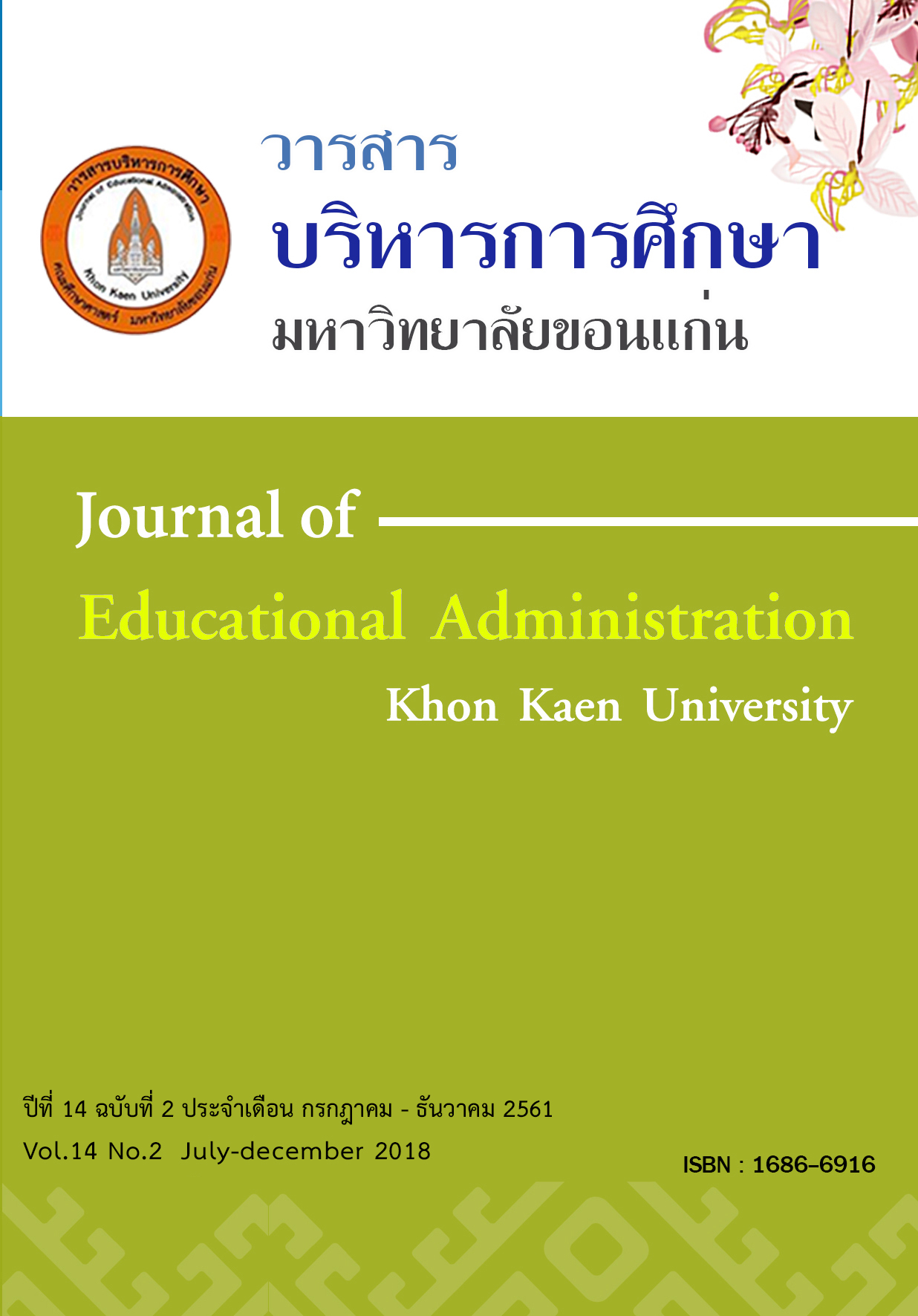โมเดลสมการโครงสร้างภาวะผู้นำของผู้บริหารและพฤติกรรมองค์การที่ส่งผลต่อองค์การสมรรถนะสูง: การวิเคราะห์อิทธิพลผ่านตัวแปรคั่นกลาง
Main Article Content
บทคัดย่อ
การวิจัยครั้งนี้ มีวัตถุประสงค์เพื่อพัฒนาและตรวจสอบความสอดคล้องของโมเดลสมการโครงสร้างภาวะผู้นำของผู้บริหารสถานศึกษาและพฤติกรรมองค์การที่ส่งผลต่อองค์การสมรรถนะสูงที่พัฒนาขึ้นกับข้อมูลเชิงประจักษ์ ขนาดอิทธิพลทางตรง อิทธิพลทางอ้อม และอิทธิพลรวมของภาวะผู้นำของผู้บริหารสถานศึกษาและพฤติกรรมองค์การผ่านการวิเคราะห์อิทธิพลผ่าตัวแปรคั่นกลางที่นำมาศึกษาต่อองค์การสมรรถนะสูง กลุ่มตัวอย่างที่ใช้ในการเก็บข้อมูลเชิงคุณภาพประกอบด้วยผู้ทรงคุณวุฒิเพื่อพิจารณาเนื้อหาองค์ประกอบ จำนวน 5 คน การเก็บข้อมูลเชิงปริมาณเพื่อตรวจสอบความสอดคล้องของโมเดลจากโรงเรียนสังกัดสำนักงานเขตพื้นที่การศึกษามัธยมศึกษา 1,075 แห่ง ทั่วประเทศ ผู้ให้ข้อมูลประกอบด้วย ผู้บริหาร 1 คน ครู 1 คน รวม 2,150 คน หน่วยวิเคราะห์ข้อมูลเป็นโรงเรียน ใช้วิธีการสุ่มแบบหลายขั้นตอน ผลการวิจัยพบว่า
โมเดลสมการโครงสร้างภาวะผู้นำของผู้บริหารสถานศึกษาและพฤติกรรมองค์การที่ส่งผลต่อองค์การสมรรถนะสูงที่ผู้วิจัยพัฒนาขึ้นมีความสอดคล้องกับข้อมูลเชิงประจักษ์ มีค่าไค-สแควร์ p-value สูงกว่า 0.05 (c2 = 48.53, df = 35 , p-value = 0.064) ค่าสัดส่วน c2 /df มีค่าไม่เกิน 2 (c2 /df = 1.386) ดัชนีความกลมกลืนมีค่าตั้งแต่ 0.90 – 1.00 (CFI = 1.000 , TLI = 0.990) RMSEA = 0.041 และ SRMR = 0.007 ปัจจัยที่มีอิทธิพลทางตรงต่อองค์การสมรรถนะสูงมากที่สุดคือ ภาวะผู้นำแบบกระจาย ( B= .548) รองลงมาคือ องค์การแห่งการเรียนรู้ (B= .509) ภาวะผู้นำการเปลี่ยนแปลง (B= .396) วัฒนธรรมการทำงานในองค์การ (B= .189) การบริหารทรัพยากรมนุษย์ (B= .135) และ ภาวะผู้นำเชิงกลยุทธ์ (B= - .170) ตามลำดับ เมื่อพิจารณาอิทธิพลทางอ้อม พบว่าองค์การสมรรถนะสูงได้รับอิทธิพลจาก ภาวะผู้นำแบบกระจาย ( B= .623) มากที่สุด รองลงมาคือ การบริหารทรัพยากรมนุษย์ (B= .492) ภาวะผู้นำการเปลี่ยนแปลง (B= .257) และภาวะผู้นำเชิงกลยุทธ์ (B= .036) และตัวแปรที่มีอิทธิพลรวมต่อองค์การสมรรถนะสูงมากที่สุดคือภาวะผู้นำแบบกระจาย ( B=1 .171) รองลงมาคือ ภาวะผู้นำการเปลี่ยนแปลง ( B= .653) การบริหารทรัพยากรมนุษย์ ( B= .627) องค์การแห่งการเรียนรู้ ( B= .509) วัฒนธรรมการทำงานในองค์การ ( B= .189) และภาวะผู้นำเชิงกลยุทธ์ ( B= .-1.33) ตามลำดับ
ผลการวิเคราะห์อิทธิพลผ่านตัวแปรคั่นกลาง พบว่าอิทธิพลรวมจากตัวแปรคั่นกลางที่ส่งผลต่อองค์การสมรรถนะสูงมากที่สุด คือ การบริหารทรัพยากรมนุษย์ (B= .627 ) ซึ่งได้รับอิทธิพลทางตรงจากภาวะผู้นำแบบกระจายมากที่สุด (B = .721) รองลงมาคือ ภาวะผู้นำการเปลี่ยนแปลง (B = .244) นอกจากนี้ การบริหารทรัพยากรมนุษย์ยังส่งผลโดยตรงต่อองค์การสมรรถนะสูง (B = .135) ส่งอิทธิพลทางอ้อม ผ่านตัวแปรองค์การแห่งการเรียนรู้ ไปสู่องค์การสมรรถนะสูง ( B= .492) ทำให้เป็นตัวแปรคั่นกลางที่มีอิทธิพลรวมที่ส่งผลต่อองค์การสมรรถนะสูงมากที่สุด รองลงมาคือตัวแปรคั่นกลางองค์การแห่งการเรียนรู้ ได้รับอิทธิพลทางตรงจาก การบริหารทรัพยากรมนุษย์ (B = .967) และภาวะผู้นำการเปลี่ยนแปลง ( B= .110) ได้รับอิทธิพลทางอ้อม จากภาวะผู้นำแบบกระจาย ( B= .697) มากที่สุด รองลงมาคือ ภาวะผู้นำการเปลี่ยนแปลง (B = .235) และ ได้รับอิทธิพลรวมจาก ภาวะผู้นำการเปลี่ยนแปลง (B = .345 ) และองค์การแห่งการเรียนรู้ยังส่งอิทธิพลทางตรงต่อองค์การสมรรถนะสูงมากที่สุด ( B= .509) ส่วนวัฒนธรรมการทำงานในองค์การเป็นตัวแปรคั่นกลางลำดับสุดท้ายที่ส่งอิทธิพลรวมต่อองค์การสมรรถนะสูง ได้รับอิทธิพลทางตรงจาก ภาวะผู้นำแบบกระจายมากที่สุด (B= .912) ได้รับจากภาวะผู้นำการเปลี่ยนแปลง ( B= .257) และ ภาวะผู้นำเชิงกลยุทธ์ (B = .195) ตามลำดับ วัฒนธรรมการทำงานในองค์การ ยังส่งผลอิทธิพลทางตรงและอิทธิพลรวมต่อองค์การสมรรถนะสูง ( B= .189)


